
List of transitional fossils
Encyclopedia
This is a tentative list of transitional fossils (fossil remains of a creature that exhibits primitive traits in comparison with more derived organisms to which it is related). The fossils are listed in series, showing the transition from one group to another, representing significant steps in the evolution of major features in various lines. These changes often represent major changes in anatomy, related to mode of life, like the acquisition of feathered wings for an aerial lifestyle in birds, or legs in the fish
/tetrapod
transition. As noted already by Darwin
, the fossil record is incomplete.
Ideally, this list would only recursively include 'true' transitionals, fossils representing ancestral specie from which later groups evolved, but most if not all, of the fossils shown here represent extinct side branches, more or less closely related to the true ancestor. They will all include details unique to their own line as well. Fossils having relatively few such traits are termed "transitional", while those with a host of traits found neither in the ancestral or derived group are called "intermediate". Since all species will always be subject to natural selection, the very term "transitional fossil" is essentially a misconception. It is however a commonly used term and a useful concept in evolutionary biology. The fossils listed represent significant steps in the evolution of major features in various lines and therefore fit the common usage of the phrase.
Nautiloid
Cephalopod
Invertebrates to Fish
Chondrichthyes
Fish
Labyrinthodonts to Modern amphibians
From Lizard
Archosaurs to Dinosaurs
Dinosaur
Synapsid
Evolution of mammals
Early Artiodactylans to whale
Evolution of sirenians
Evolution of the horse
Human evolution
Fish
Fish are a paraphyletic group of organisms that consist of all gill-bearing aquatic vertebrate animals that lack limbs with digits. Included in this definition are the living hagfish, lampreys, and cartilaginous and bony fish, as well as various extinct related groups...
/tetrapod
Tetrapod
Tetrapods are vertebrate animals having four limbs. Amphibians, reptiles, birds and mammals are all tetrapods; even snakes and other limbless reptiles and amphibians are tetrapods by descent. The earliest tetrapods evolved from the lobe-finned fishes in the Devonian...
transition. As noted already by Darwin
Charles Darwin
Charles Robert Darwin FRS was an English naturalist. He established that all species of life have descended over time from common ancestry, and proposed the scientific theory that this branching pattern of evolution resulted from a process that he called natural selection.He published his theory...
, the fossil record is incomplete.
Ideally, this list would only recursively include 'true' transitionals, fossils representing ancestral specie from which later groups evolved, but most if not all, of the fossils shown here represent extinct side branches, more or less closely related to the true ancestor. They will all include details unique to their own line as well. Fossils having relatively few such traits are termed "transitional", while those with a host of traits found neither in the ancestral or derived group are called "intermediate". Since all species will always be subject to natural selection, the very term "transitional fossil" is essentially a misconception. It is however a commonly used term and a useful concept in evolutionary biology. The fossils listed represent significant steps in the evolution of major features in various lines and therefore fit the common usage of the phrase.
NautiloidNautiloidNautiloids are a large and diverse group of marine cephalopods belonging to the subclass Nautiloidea that began in the Late Cambrian and are represented today by the living Nautilus. Nautiloids flourished during the early Paleozoic era, where they constituted the main predatory animals, and...
s to Ammonoids
| The Nautiloids → Ammonoids Evolutionary Series | |||||
|---|---|---|---|---|---|
| Appearance | Taxa | Relationships | Status | Description | Image |
| >500 Ma | Subclass:
|
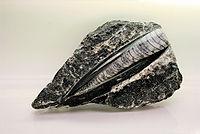 |
|||
| 390 Ma |
Order:
|
|
|||
| 370 Ma |
Subclass:
|
|
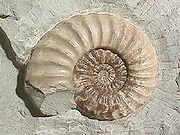 |
||
CephalopodCephalopodA cephalopod is any member of the molluscan class Cephalopoda . These exclusively marine animals are characterized by bilateral body symmetry, a prominent head, and a set of arms or tentacles modified from the primitive molluscan foot...
s
| The Cephalopod Cephalopod A cephalopod is any member of the molluscan class Cephalopoda . These exclusively marine animals are characterized by bilateral body symmetry, a prominent head, and a set of arms or tentacles modified from the primitive molluscan foot... Evolutionary Series |
|||||
|---|---|---|---|---|---|
| Appearance | Taxa | Relationships | Status | Description | Image |
| 296 Ma | Genus
|
The earliest described octopod. | |||
| 164 Ma |
Genus:
|
A primitive octopod. | 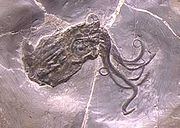 |
||
| 165–164 Ma |
Genus:
|
An early Vampyromorphida Vampyromorphida Vampyromorphida is an order of cephalopods comprising one known extant species and many extinct taxa. Physically, they somewhat resemble octopuses, but the eight main tentacles are united by a web of skin, and two smaller tentacles are also present.-Classification:*Order Vampyromorphida**?Suborder... . |
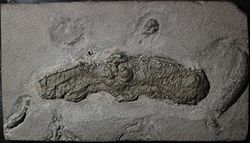 |
||
| 89 - 71 Ma |
Genus:
|
A primitive octopod. |  |
||
Evolution of insects
| The Insect Insect Insects are a class of living creatures within the arthropods that have a chitinous exoskeleton, a three-part body , three pairs of jointed legs, compound eyes, and two antennae... Evolutionary Series |
|||||
|---|---|---|---|---|---|
| Appearance | Taxa | Relationships | Status | Description | Image |
| 400 Ma | Genus:
|
The world’s oldest known insect. |
|||
| 400 Ma | Genus:
|
Early springtail Springtail Springtails form the largest of the three lineages of modern hexapods that are no longer considered insects... . |
|||
| 300 Ma | Genus:
|
An ancestral to cockroach Cockroach Cockroaches are insects of the order Blattaria or Blattodea, of which about 30 species out of 4,500 total are associated with human habitations... es, mantids and termites. |
|||
| 316.5 Ma | Genus:
|
A primitive cockroach. |
|||
| 140 Ma | Genus:
|
The earliest known Lepidopteran. |
|||
| 92 Ma | Genus:
|
The oldest known species of bee Bee Bees are flying insects closely related to wasps and ants, and are known for their role in pollination and for producing honey and beeswax. Bees are a monophyletic lineage within the superfamily Apoidea, presently classified by the unranked taxon name Anthophila... . |
|||
| 80 Ma | Genus:
|
The earliest known species of ant Ant Ants are social insects of the family Formicidae and, along with the related wasps and bees, belong to the order Hymenoptera. Ants evolved from wasp-like ancestors in the mid-Cretaceous period between 110 and 130 million years ago and diversified after the rise of flowering plants. More than... . |
|||
| 56 - 34 Ma | Genus:
|
First leaf insect from the fossil record. | |||
Evolution of spiders
| The Spider Spider Spiders are air-breathing arthropods that have eight legs, and chelicerae with fangs that inject venom. They are the largest order of arachnids and rank seventh in total species diversity among all other groups of organisms... Evolutionary Series |
|||||
|---|---|---|---|---|---|
| Appearance | Taxa | Relationships | Status | Description | Image |
| 390 Ma | Genus:
|
Previously thought to be the world's oldest spider. | |||
| 165 Ma |
Genus
|
The oldest known haplogyne spider. | |||
Invertebrates to FishFishFish are a paraphyletic group of organisms that consist of all gill-bearing aquatic vertebrate animals that lack limbs with digits. Included in this definition are the living hagfish, lampreys, and cartilaginous and bony fish, as well as various extinct related groups...
| The Invertebrates → Fish Fish Fish are a paraphyletic group of organisms that consist of all gill-bearing aquatic vertebrate animals that lack limbs with digits. Included in this definition are the living hagfish, lampreys, and cartilaginous and bony fish, as well as various extinct related groups... Evolutionary Series |
|||||
|---|---|---|---|---|---|
| Appearance | Taxa | Relationships | Status | Description | Image |
| ??? Ma | Genus:
|
Lancelet Lancelet The lancelets , also known as amphioxus, are the modern representatives of the subphylum Cephalochordata, formerly thought to be the sister group of the craniates. They are usually found buried in sand in shallow parts of temperate or tropical seas. In Asia, they are harvested commercially as food... -like in appearance. Oldest known ancestor of modern vertebrates Vertebrate characters
|
 |
||
| ??? Ma | Class:
|
Had fin rays, chevron-shaped muscles and a notochord. | 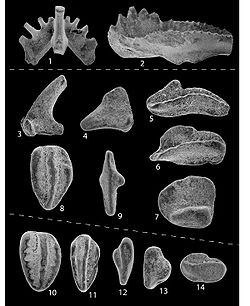 |
||
| 530 Ma |
Genus:
|
Appears to have a cranium, thus being a craniat Craniata Craniata is a proposed clade of chordate animals that contains the Myxini , Petromyzontida , and Gnathostomata as living representatives... . |
|||
| 480 to 470 Ma |
Genus:
|
Jawless fish Agnatha Agnatha is a superclass of jawless fish in the phylum Chordata, subphylum Vertebrata. The group excludes all vertebrates with jaws, known as gnathostomes.... |
A well armoured jawless fish Agnatha Agnatha is a superclass of jawless fish in the phylum Chordata, subphylum Vertebrata. The group excludes all vertebrates with jaws, known as gnathostomes.... , resembling a large tadpole in life |
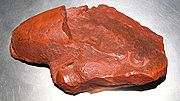 |
|
| ??? Ma |
Genus:
|
An anaspid Anaspida The Anaspida are stem gnathostomes, and are classically regarded as the ancestors of lampreys. Anaspids were small marine agnathans that lacked scales and paired fins, but have a striking highly hypocercal tail... , ancestral to the jawed vertebrates, |
A rather lightly armoured jawless fish Agnatha Agnatha is a superclass of jawless fish in the phylum Chordata, subphylum Vertebrata. The group excludes all vertebrates with jaws, known as gnathostomes.... |
 |
|
| 419 Ma |
Genus:
|
Oldest known bony fish Osteichthyes Osteichthyes , also called bony fish, are a taxonomic group of fish that have bony, as opposed to cartilaginous, skeletons. The vast majority of fish are osteichthyes, which is an extremely diverse and abundant group consisting of over 29,000 species... |
 |
||
ChondrichthyesChondrichthyesChondrichthyes or cartilaginous fishes are jawed fish with paired fins, paired nares, scales, two-chambered hearts, and skeletons made of cartilage rather than bone...
| The Chondrichthyes Chondrichthyes Chondrichthyes or cartilaginous fishes are jawed fish with paired fins, paired nares, scales, two-chambered hearts, and skeletons made of cartilage rather than bone... Evolutionary Series |
|||||
|---|---|---|---|---|---|
| Appearance | Taxa | Relationships | Status | Description | Image |
| 370 Ma | Genus:
|
An early primitive shark. | 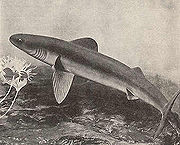 |
||
| 70 - 65 Ma |
Genus:
|
A early Sawfish Sawfish Sawfish, also known as the Carpenter Shark, are a family of rays, characterized by a long, toothy nose extension snout. Several species can grow to approximately . The family as a whole is largely unknown and little studied... |
|||
| 99 – 65 Ma |
Genus:
|
An early stingray Stingray The stingrays are a group of rays, which are cartilaginous fishes related to sharks. They are classified in the suborder Myliobatoidei of the order Myliobatiformes, and consist of eight families: Hexatrygonidae , Plesiobatidae , Urolophidae , Urotrygonidae , Dasyatidae , Potamotrygonidae The... -like skate Skate Skates are cartilaginous fish belonging to the family Rajidae in the superorder Batoidea of rays. There are more than 200 described species in 27 genera. There are two subfamilies, Rajinae and Arhynchobatinae .... . |
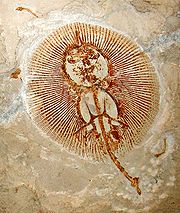 |
||
Bony Fish
| The Bony Fish Evolutionary Series | |||||
|---|---|---|---|---|---|
| Appearance | Taxa | Relationships | Status | Description | Image |
| 420 Ma | Genus:
|
The earliest-known Actinopterygii Actinopterygii The Actinopterygii or ray-finned fishes constitute a class or sub-class of the bony fishes.The ray-finned fishes are so called because they possess lepidotrichia or "fin rays", their fins being webs of skin supported by bony or horny spines , as opposed to the fleshy, lobed fins that characterize... an. |
|||
| ??? Ma | Genus:
|
An early relative of the Flatfish Flatfish The flatfish are an order of ray-finned fish, also called the Heterosomata, sometimes classified as a suborder of Perciformes. In many species, both eyes lie on one side of the head, one or the other migrating through and around the head during development... . |
|||
| 48 – 37 Ma |
Genus:
|
An early flatfish Flatfish The flatfish are an order of ray-finned fish, also called the Heterosomata, sometimes classified as a suborder of Perciformes. In many species, both eyes lie on one side of the head, one or the other migrating through and around the head during development... |
|||
| 183.7–125.0 Ma |
Genus:
|
One of the first teleosts. |  |
||
| 99 – 93 Ma |
Genus:
|
The oldest known eel Eel Eels are an order of fish, which consists of four suborders, 20 families, 111 genera and approximately 800 species. Most eels are predators... . |
|||
| 13 Ma |
Genus:
|
One of the oldest known seahorse Seahorse Seahorses compose the fish genus Hippocampus within the family Syngnathidae, in order Syngnathiformes. Syngnathidae also includes the pipefishes. "Hippocampus" comes from the Ancient Greek hippos meaning "horse" and kampos meaning “sea monster”.There are nearly 50 species of seahorse... . |
|||
| 13 Ma |
Genus:
|
One of the oldest known seahorse Seahorse Seahorses compose the fish genus Hippocampus within the family Syngnathidae, in order Syngnathiformes. Syngnathidae also includes the pipefishes. "Hippocampus" comes from the Ancient Greek hippos meaning "horse" and kampos meaning “sea monster”.There are nearly 50 species of seahorse... . |
|||
| 83 - 70 Ma |
Genus:
|
The oldest known lamprid fish | |||
| 56 - 34 Ma |
Genus:
|
A primitive sunfish Molidae Molidae is the family of the molas or ocean sunfishes, unique fish whose bodies come to an end just behind the dorsal and anal fins, giving them a "half-a-fish" appearance... |
|||
| 58 - 55 Ma |
Genus:
|
The oldest known member of the catfish Catfish Catfishes are a diverse group of ray-finned fish. Named for their prominent barbels, which resemble a cat's whiskers, catfish range in size and behavior from the heaviest and longest, the Mekong giant catfish from Southeast Asia and the second longest, the wels catfish of Eurasia, to detritivores... family Callichthyidae Callichthyidae Callichthyidae is a family of catfishes , called armored catfishes due to the two rows of bony plates running down the length of the body. This family contains some of the most popular freshwater aquarium fish, such as the Corydoras.-Taxonomy:The family derives its name from the Greek words kallis... . |
|||
| 56 - 34 Ma |
Genus:
|
A primitive rabbitfish Rabbitfish Rabbitfishes or spinefoots are perciform fishes in the family Siganidae. The 28 species are in a single genus, Siganus. In some now obsolete classifications, the species having prominent face stripes—colloquially called foxfaces–are in the genus Lo. Other species like the Masked... . |
|||
| 48 - 37 Ma |
Genus:
|
A primitive perch Perch Perch is a common name for fish of the genus Perca, freshwater gamefish belonging to the family Percidae. The perch, of which there are three species in different geographical areas, lend their name to a large order of vertebrates: the Perciformes, from the Greek perke meaning spotted, and the... |
|||
| 58 - 55 Ma |
Genus:
|
A primitive pomfret Pomfret Pomfret are perciform fishes belonging to the family Bramidae.They are found in the Atlantic, Indian, and Pacific Oceans, and the largest species, the Atlantic pomfret, Brama brama, grows up to long.... |
|||
| 48 - 40 Ma |
Genus:
|
A early handfish Handfish Handfish are anglerfish in the family Brachionichthyidae, a group which comprises five genera and fourteen extant species.They are small bottom-dwelling marine fish found in coastal waters of southern Australia and Tasmania. Their skin is covered with denticles , giving them the name warty anglers... |
|||
| 48 - 40 Ma |
Genus:
|
The oldest ostraciid boxfish Boxfish Ostraciidae is a family of squared, bony fish belonging to the order Tetraodontiformes, closely related to the pufferfishes and filefishes. Fish in the family are known variously as boxfishes, cofferfishes, cowfishes and trunkfishes... |
|||
| 48 - 40 Ma |
Genus:
|
A primitive aracanid boxfish Boxfish Ostraciidae is a family of squared, bony fish belonging to the order Tetraodontiformes, closely related to the pufferfishes and filefishes. Fish in the family are known variously as boxfishes, cofferfishes, cowfishes and trunkfishes... |
|||
| 48 - 40 Ma |
Genus:
|
A basal surgeonfish | |||
| 48 - 40 Ma |
Genus:
|
A primitive monodactylid moonyfish | |||
| 48 - 40 Ma |
Genus:
|
A primitive monodactylid moonyfish | |||
| 48 - 40 Ma |
Genus:
|
A short-snouted ancestor of the modern Moorish Idol Moorish Idol The moorish idol, Zanclus cornutus , is a small marine fish species, the sole extant representative of the family Zanclidae in order Perciform. A common inhabitant of tropical to subtropical reefs and lagoons, the moorish idol is notable for its wide distribution throughout the Indo-Pacific... . |
|||
| 83 - 65 Ma |
Genus:
|
A primitive Tetraodontidae | |||
| 83 - 65 Ma |
Genus:
|
A primitive Perciforme | |||
| 58 - 55 Ma |
Genus:
|
A primitive Zeidae Zeidae The Zeidae are a family of large, showy, deep-bodied zeiform marine fish—the "true dories". Found in the Atlantic, Indian, and Pacific Ocean, the family contains just six species in two genera... |
|||
| 58 - 55 Ma |
Genus:
|
A primitive Zeidae Zeidae The Zeidae are a family of large, showy, deep-bodied zeiform marine fish—the "true dories". Found in the Atlantic, Indian, and Pacific Ocean, the family contains just six species in two genera... |
|||
| ??? Ma |
Genus:
|
A primitive Ichthyodectidae Ichthyodectidae The family Ichthyodectidae was a family of marine actinopterygian fish. Sometimes classified in the primitive bony fish order Pachycormiformes, they are today generally regarded as members of the "bulldog fish" order Ichthyodectiformes in the far more advanced Osteoglossomorpha... |
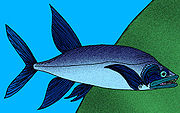 |
||
| 65 Ma |
Genus:
|
A primitive tetraodontid | |||
FishFishFish are a paraphyletic group of organisms that consist of all gill-bearing aquatic vertebrate animals that lack limbs with digits. Included in this definition are the living hagfish, lampreys, and cartilaginous and bony fish, as well as various extinct related groups...
to Tetrapods
| The Fish Fish Fish are a paraphyletic group of organisms that consist of all gill-bearing aquatic vertebrate animals that lack limbs with digits. Included in this definition are the living hagfish, lampreys, and cartilaginous and bony fish, as well as various extinct related groups... → Tetrapods Evolutionary Series |
|||||
|---|---|---|---|---|---|
| Appearance | Taxa | Relationships | Status | Description | Image |
| 416-359 Ma | Genus:
|
An early member of the Tetrapodomorpha Tetrapodomorpha Tetrapodomorpha is a clade of vertebrates, consisting of tetrapods and their closest sarcopterygian relatives that are more closely related to living tetrapods than to living lungfish... , the piscine line leading to tetrapods, Osteolepis Osteolepis Osteolepis is an extinct genus of lobe-finned fish from the Devonian period. It lived in the Orcadian Lakes of northern Scotland.... is generalised enough to give a fair approximation of the common ancestor of tetrapods and lungfish Lungfish Lungfish are freshwater fish belonging to the Subclass Dipnoi. Lungfish are best known for retaining characteristics primitive within the Osteichthyes, including the ability to breathe air, and structures primitive within Sarcopterygii, including the presence of lobed fins with a well-developed... . |
Fish | A small to medium sized sarcopterygian fish with internal nostrils and pectoral fins stiffened by bony components broadly homologous Homology (biology) Homology forms the basis of organization for comparative biology. In 1843, Richard Owen defined homology as "the same organ in different animals under every variety of form and function". Organs as different as a bat's wing, a seal's flipper, a cat's paw and a human hand have a common underlying... to the humerus Humerus The humerus is a long bone in the arm or forelimb that runs from the shoulder to the elbow.... and radius Radius (bone) The radius is one of the two large bones of the forearm, the other being the ulna. It extends from the lateral side of the elbow to the thumb side of the wrist and runs parallel to the ulna, which exceeds it in length and size. It is a long bone, prism-shaped and slightly curved longitudinally... /ulna Ulna The ulna is one of the two long bones in the forearm, the other being the radius. It is prismatic in form and runs parallel to the radius, which is shorter and smaller. In anatomical position The ulna is one of the two long bones in the forearm, the other being the radius. It is prismatic in form... found in tetrapods. |
|
| 385 Ma |
Genus:
|
Belonging to the family Tristichopteridae Tristichopteridae Tristichopterids , were a diverse and successful group of tetrapodomorph fishes throughout the Late Devonian stage. They first appeared in the Givetian epoch of the Middle Devonian stage... , a family Family (biology) In biological classification, family is* a taxonomic rank. Other well-known ranks are life, domain, kingdom, phylum, class, order, genus, and species, with family fitting between order and genus. As for the other well-known ranks, there is the option of an immediately lower rank, indicated by the... that form a sister group to Panderichthys Panderichthys Panderichthys is a 90–130 cm long fish from the Devonian period 397 million years ago, of Latvia. It is named after the german-baltic palaeontologist Christian Heinrich Pander. It has a large tetrapod-like head... and the tetrapods. |
Though not on the evolutionary path to tetrapods, Eusthenopteron is of fairly general build and is very well known, serving as an iconic model organism in tetrapod evolution. | A medium sized, mainly pelagic fish, Eusthenopteron Eusthenopteron Eusthenopteron is a genus of prehistoric lobe-finned fish which has attained an iconic status from its close relationships to tetrapods. Early depictions of this animal show it emerging onto land, however paleontologists now widely agree that it was a strictly aquatic animal... mainly use the pectoral and pelvic fins for navigation, and the tail for propulsion. The fin was of diphycercal, foreshadowing the straightening of the spine and the evolution of a contiguous fin in fish like Panderichthys Panderichthys Panderichthys is a 90–130 cm long fish from the Devonian period 397 million years ago, of Latvia. It is named after the german-baltic palaeontologist Christian Heinrich Pander. It has a large tetrapod-like head... |
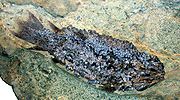 |
| 380 Ma |
Genus:
|
Very close to the origin of tetrapods, a "fishapod". | Fish | A large, predatory shallow water fish. As common in shallow water fish, the pectoral and pelvic fins was flexible and paddle-like for propulsion. The dorsal and anal fins are lost, the tail fin contiguous. The spiracle Spiracle Spiracles are openings on the surface of some animals that usually lead to respiratory systems.-Vertebrates:The spiracle is a small hole behind each eye that opens to the mouth in some fishes. In the primitive jawless fish the first gill opening immediately behind the mouth is essentially similar... s were short and wide, indication large amount of oxygen were taken up by the lungs rather than through the gills. |
 |
| 375 Ma |
Genus:
|
A "fishapod" more tetrapod-like than Panderichthys Panderichthys Panderichthys is a 90–130 cm long fish from the Devonian period 397 million years ago, of Latvia. It is named after the german-baltic palaeontologist Christian Heinrich Pander. It has a large tetrapod-like head... . |
A fish, transitional between fish and the early, fish-like labyrinthodonts. | "Fish" with stout, fleshy pectoral fins with a joint between the innermost and the two next bony elements, corresponding to the elbow in higher tetrapods. The cleithrum Cleithrum The cleithrum is a membrane bone which first appears as part of the skeleton in primitive bony fish, where it runs vertically along the scapula. Its name is derived from Greek κλειθρον = "key ", by analogy with "clavicle" from Latin clavicula = "little key".In modern fishes, the cleithrum is a... bone was free of the skull, functioning as anchoring for the pectoral fins, and at the same time allowing for movement of the neck. |
|
| 368 Ma |
Genus:
|
A fairly fragmentary find, Elginerpeton straddles the fish/tetrapod divide with a mosaic of features resembling 'Panderichthys Panderichthys Panderichthys is a 90–130 cm long fish from the Devonian period 397 million years ago, of Latvia. It is named after the german-baltic palaeontologist Christian Heinrich Pander. It has a large tetrapod-like head... , Ichthyostega Ichthyostega Ichthyostega is an early tetrapod genus that lived at the end of the Upper Devonian period . It was a labyrinthodont, one of the first fossil record of tetrapods. Ichthyostega possessed lungs and limbs that helped it navigate through shallow water in swamps... and Hynerpeton Hynerpeton Hynerpeton was a basal carnivorous tetrapod that lived in the lakes and estuaries of the Late Devonian period around 360 million years ago. Like many primitive tetrapods, it is sometimes referred to as an "amphibian", though it is not a true member of the modern Lissamphibia... . Probably one of the "fishapods". |
 |
||
| 365 Ma |
Genus:
|
Morphologically midway between Tiktaalik Tiktaalik Tiktaalik is a genus of extinct sarcopterygian from the late Devonian period, with many features akin to those of tetrapods . It is an example from several lines of ancient sarcopterygian "fish" developing adaptations to the oxygen-poor shallow-water habitats of its time, which led to the... and Acanthostega Acanthostega Acanthostega is an extinct labyrinthodont genus, among the first vertebrate animals to have recognizable limbs. It appeared in the Upper Devonian about 365 million years ago, and was anatomically intermediate between lobe-finned fishes and the first tetrapods fully capable of coming onto... /Ichthyostega Ichthyostega Ichthyostega is an early tetrapod genus that lived at the end of the Upper Devonian period . It was a labyrinthodont, one of the first fossil record of tetrapods. Ichthyostega possessed lungs and limbs that helped it navigate through shallow water in swamps... . |
Possibly oldest animal to have feet rather than fins. | A large, dorso-ventrally flattened predatory fish with a well armoured labyrinthodont-like skull. While the fins themselves has not been found, the shoulder girdle is essentially similar to that of Acanthostega, indicating it too had feet rather than fins. |  |
| 365 Ma |
Genus:
|
Together with Ichthyostega Ichthyostega Ichthyostega is an early tetrapod genus that lived at the end of the Upper Devonian period . It was a labyrinthodont, one of the first fossil record of tetrapods. Ichthyostega possessed lungs and limbs that helped it navigate through shallow water in swamps... the sole early labyrinthodont known from fairly complete skeletons. It is the oldest animal known to have feet rather than fins, thus making it a true tetrapod Tetrapod Tetrapods are vertebrate animals having four limbs. Amphibians, reptiles, birds and mammals are all tetrapods; even snakes and other limbless reptiles and amphibians are tetrapods by descent. The earliest tetrapods evolved from the lobe-finned fishes in the Devonian... . |
First known animal with toes rather than fins. The feet was broad and paddle-like, adapted for movement in water. It retained functional gills in adulthood, behind a fleshy operculum Operculum Operculum may refer to:*Operculum , a stiff structure resembling a lid or a small door that opens and closes**Operculum , a lid on the shell of some gastropods**Operculum , a lid on the orifice of some bryozoans... . |
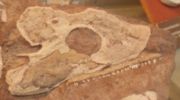 |
|
| 365 Ma |
Genus:
|
Fairly closely related to Acanthostega Acanthostega Acanthostega is an extinct labyrinthodont genus, among the first vertebrate animals to have recognizable limbs. It appeared in the Upper Devonian about 365 million years ago, and was anatomically intermediate between lobe-finned fishes and the first tetrapods fully capable of coming onto... . It possibly represent an early (and ultimately unsuccessful) line adapted to moving on land by inchworm Inchworm Inchworms are the caterpillars of geometer moths.Inchworm can also mean:*Inchworm , a song from the film Hans Christian Andersen*Inchworm , a ride-on toy manufactured by Hasbro in the 1970s... -like movements. |
Together with Acanthostega the sole early labyrinthodont known from fairly complete skeletons. | Early labyrinthodont with polydactylous Polydactyly in early tetrapods Polydactyly in early tetrapod aquatic animals is not to be confused with polydactyly in the medical sense, i.e., it was not an anomaly in the sense it was not a condition of having more than the typical number of digits for a given taxon. The condition appear to have arisen from a limb with a fin... , paddle-like feet and reinforced vertebrae and neural spines. It probably spent time on land, yet retained gills and a tail with fin rayes. |
|
| 360 Ma |
Genus:
|
A large, basically salamander Salamander Salamander is a common name of approximately 500 species of amphibians. They are typically characterized by a superficially lizard-like appearance, with their slender bodies, short noses, and long tails. All known fossils and extinct species fall under the order Caudata, while sometimes the extant... -like creature. The shoulder girdle was powerful, indicating it was a competent walker. |
 |
||
| ??? Ma |
Genus:
|
A large animal with paddle-like six-toed feet. It did however not have gills in adulthood, and is thus the oldest labyrinthodont known to depend entirely on breathing with its lungs. | 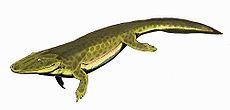 |
||
| 359 - 345 Ma |
Genus:
|
Hailing from the fossil-poor Romer's Gap Romer's gap Romer's Gap is an example of a gap in the fossil record used in the study of evolution. Such gaps represent a period from which excavators have found no or very few fossils. Romer's gap is named after paleontologist Dr... , Pederpes may be ancestral to the higher labyrinthodonts. |
Intermediate between the earlier Ichthyostegalian and the later, more advanced labyrinthodonts. | Despite an extra toe on the forelimbs, Pederpes had limbs that terminated in feet adapted primarely for walking rather than paddles for combined swimming and walking like the earlier groups. |  |
| 295 Ma |
Genus:
|
The Temnospondyli Temnospondyli Temnospondyli is a diverse order of small to giant tetrapods—often considered primitive amphibians—that flourished worldwide during the Carboniferous, Permian, and Triassic periods. A few species continued into the Cretaceous. Fossils have been found on every continent... are derived paleozoic amphibians, possibly ancestral to modern amphibians Lissamphibia The subclass Lissamphibia includes all recent amphibians and means smooth amphibia.Extant amphibians fall into one of three orders — the Anura , the Caudata or Urodela , and the Gymnophiona or Apoda .Although the ancestry of each group is still unclear, all share certain common characteristics,... |
A "classical" temnospondyl Temnospondyli Temnospondyli is a diverse order of small to giant tetrapods—often considered primitive amphibians—that flourished worldwide during the Carboniferous, Permian, and Triassic periods. A few species continued into the Cretaceous. Fossils have been found on every continent... , an advanced labyrinthodont group. |
One of the best known labyrinthodonts, Eryops combines the large, flat skull and short limbs typical of the group. | 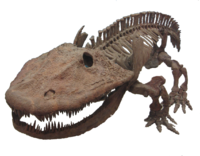 |
Labyrinthodonts to Modern amphibiansLissamphibiaThe subclass Lissamphibia includes all recent amphibians and means smooth amphibia.Extant amphibians fall into one of three orders — the Anura , the Caudata or Urodela , and the Gymnophiona or Apoda .Although the ancestry of each group is still unclear, all share certain common characteristics,...
| The Labyrinthodontia Labyrinthodontia Labyrinthodontia is an older term for any member of the extinct subclass of amphibians, which constituted some of the dominant animals of Late Paleozoic and Early Mesozoic times . The group is ancestral to all extant landliving vertebrates, and as such constitutes an evolutionary grade rather... → Lissamphibia Lissamphibia The subclass Lissamphibia includes all recent amphibians and means smooth amphibia.Extant amphibians fall into one of three orders — the Anura , the Caudata or Urodela , and the Gymnophiona or Apoda .Although the ancestry of each group is still unclear, all share certain common characteristics,... Evolutionary Series |
|||||
|---|---|---|---|---|---|
| Appearance | Taxa | Relationships | Status | Description | Image |
| 290 Ma | Genus:
|
Colloquially referred to as a "frogamander" due to this taxon being both chronologically and morphologically basal to both anurans and salamanders | One of the first transitional fossils towards modern amphibians (Lissamphibia Lissamphibia The subclass Lissamphibia includes all recent amphibians and means smooth amphibia.Extant amphibians fall into one of three orders — the Anura , the Caudata or Urodela , and the Gymnophiona or Apoda .Although the ancestry of each group is still unclear, all share certain common characteristics,... ). |
Plesiomorphic traits
Derived traits
|
|
| 250 Ma | Genus:
|
Intermediate between generalized amphibians and derived frogs | Early "almost frog" transitional amphibian | Plesiomorphic traits
Derived traits
|
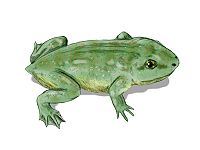 |
| 190 Ma | Genus:
|
Another transitional form which could be properly classified as a frog | An intermediate form which may replace Triadobatrachus Triadobatrachus Triadobatrachus is an extinct genus of frog-like amphibian, including only one known species, Triadobatrachus massinoti. It is the oldest frog known to science, and an excellent example of a transitional fossil... as the "ultimate" ancestor of anurans |
Plesiomorphic traits
Derived traits
|
 |
| 213-188 Ma |
Genus:
|
A derived fossil frog completing the series of transitional fossils between early amphibians and modern anurans | The oldest "true" frog | Plesiomorphic traits
Derived traits
|
|
| 210 Ma | Genus:
|
Intermediate between basal amphibians and caecilian Caecilian The caecilians are an order of amphibians that superficially resemble earthworms or snakes. They mostly live hidden in the ground, making them the least familiar order of amphibians. All extant caecilians and their closest fossil relatives are grouped as the clade Apoda. They are mostly... s |
An early caecilian Caecilian The caecilians are an order of amphibians that superficially resemble earthworms or snakes. They mostly live hidden in the ground, making them the least familiar order of amphibians. All extant caecilians and their closest fossil relatives are grouped as the clade Apoda. They are mostly... |
Plesiomorphic traits
Derived traits
|
 |
Amphibians to Amniotes (early reptiles)
| The Amphibians → Reptiles Evolutionary Series | |||||
|---|---|---|---|---|---|
| Appearance | Taxa | Relationships | Status | Description | Image |
| 326 - 318 Ma | Genus:
|
One of the early reptile-like Reptiliomorpha Reptiliomorpha refers to an order or subclass of reptile-like amphibians, which gave rise to the amniotes in the Carboniferous. Under phylogenetic nomenclature, the Reptiliomorpha includes their amniote descendants though, even in phylogenetic nomenclature, the name is mostly used when referring to... amphibians |
Amphibian | A large, somewhat lizard-like labyrinthodont with a deep skull, laterally placed eyes and five digits to each foot. | |
| ??? Ma |
Genus:
|
The order Diadectomorpha Diadectomorpha Diadectomorpha are a clade of large reptile-like amphibians that lived in Euramerica during the Carboniferous and Early Permian periods, and are very close to the ancestry of the Amniota. They include both large carnivorous and even larger herbivorous forms, some semi-aquatic and others fully... is the sister group of the amniote Amniote The amniotes are a group of tetrapods that have a terrestrially adapted egg. They include synapsids and sauropsids , as well as their fossil ancestors. Amniote embryos, whether laid as eggs or carried by the female, are protected and aided by several extensive membranes... s. |
The Limnoscelis was originally described as a "cotylosaur" (early reptiles) together with the other diadectomorpha Diadectomorpha Diadectomorpha are a clade of large reptile-like amphibians that lived in Euramerica during the Carboniferous and Early Permian periods, and are very close to the ancestry of the Amniota. They include both large carnivorous and even larger herbivorous forms, some semi-aquatic and others fully... ns. Today the large-bodied diadectomorphs are thought to have had a larval stage, falling close to, but just outside the amphibian/reptile divide. |
A large, predatory reptile-like amphibian. The limbs are extremely heavily built, indicating it fed on slow moving prey. | -redpathmuseummontreal-june6-08.png) |
| ??? Ma |
Genus:
|
Uncertain phylogeny, possibly a Seymouriamorph Seymouriamorpha Seymouriamorpha were a small but widespread group of reptiliomorphs. Many seymouriamorphs were terrestrial or semi-aquatic. However, aquatic larvae bearing external gills and grooves from the lateral line system has been found, making them unquestionably amphibians. The adults were terrestrial... or Diadectomorph Diadectomorpha Diadectomorpha are a clade of large reptile-like amphibians that lived in Euramerica during the Carboniferous and Early Permian periods, and are very close to the ancestry of the Amniota. They include both large carnivorous and even larger herbivorous forms, some semi-aquatic and others fully... |
Amphibian | A medium sized, probably herbivorious animal |  |
| 350 Ma |
Genus:
|
Uncertain phylogenetic position. Westlothiana may be a small-bodied diadectopmorph Diadectomorpha Diadectomorpha are a clade of large reptile-like amphibians that lived in Euramerica during the Carboniferous and Early Permian periods, and are very close to the ancestry of the Amniota. They include both large carnivorous and even larger herbivorous forms, some semi-aquatic and others fully... , falling just outside the amphibian/reptile divide |
Originally described as the first reptile Reptile Reptiles are members of a class of air-breathing, ectothermic vertebrates which are characterized by laying shelled eggs , and having skin covered in scales and/or scutes. They are tetrapods, either having four limbs or being descended from four-limbed ancestors... , it is now considered an advanced reptile-like amphibian Reptiliomorpha Reptiliomorpha refers to an order or subclass of reptile-like amphibians, which gave rise to the amniotes in the Carboniferous. Under phylogenetic nomenclature, the Reptiliomorpha includes their amniote descendants though, even in phylogenetic nomenclature, the name is mostly used when referring to... . |
Small, probably insectovorious animal. The body and tail was long, the limbs small, somewhat like a modern skink Skink Skinks are lizards belonging to the family Scincidae. Together with several other lizard families, including Lacertidae , they comprise the superfamily or infraorder Scincomorpha... . |
|
| 320-305 Ma |
Genus:
|
Possibly allied to the Diadectomorpha Diadectomorpha Diadectomorpha are a clade of large reptile-like amphibians that lived in Euramerica during the Carboniferous and Early Permian periods, and are very close to the ancestry of the Amniota. They include both large carnivorous and even larger herbivorous forms, some semi-aquatic and others fully... , or belinging to a sister group to Diadectomorpha and Amniota |
Likely an amphibian | Smallish, likely carnivorious. |  |
| 340 Ma |
Genus:
|
The fragmentary nature of the fossil (it lacks a cranium) makes an exact phylogenetic position hard to establish. | Possibly the first animal with an amniote Amniote The amniotes are a group of tetrapods that have a terrestrially adapted egg. They include synapsids and sauropsids , as well as their fossil ancestors. Amniote embryos, whether laid as eggs or carried by the female, are protected and aided by several extensive membranes... egg, and thus the first reptile. |
Small lizard-like animal, the first known tetrapod Tetrapod Tetrapods are vertebrate animals having four limbs. Amphibians, reptiles, birds and mammals are all tetrapods; even snakes and other limbless reptiles and amphibians are tetrapods by descent. The earliest tetrapods evolved from the lobe-finned fishes in the Devonian... to possess claws, indicating it has reptilian type skin with scute Scute A scute or scutum is a bony external plate or scale, as on the shell of a turtle, the skin of crocodilians, the feet of some birds or the anterior portion of the mesonotum in insects.-Properties:... s. |
|
| 315 Ma |
Genus:
|
One of several small, basal reptile genera | Reptile | An early anapsid Anapsid An anapsid is an amniote whose skull does not have openings near the temples.While "anapsid reptiles" or "anapsida" are traditionally spoken of as if they were a monophyletic group, it has been suggested that several groups of reptiles that had anapsid skulls may be only distantly related... reptile, considered to be ancestral to both the synapsid Synapsid Synapsids are a group of animals that includes mammals and everything more closely related to mammals than to other living amniotes. They are easily separated from other amniotes by having an opening low in the skull roof behind each eye, leaving a bony arch beneath each, accounting for their name... and sauropsid Sauropsida Sauropsida is a group of amniotes that includes all existing reptiles and birds and their fossil ancestors, including the dinosaurs, the immediate ancestors of birds... lines, and thus the oldest representative of the crown group Crown group A crown group is a group consisting of living representatives, their ancestors back to the most recent common ancestor of that group, and all of that ancestor's descendants. The name was given by Willi Hennig, the formulator of phylogenetic systematics, as a way of classifying living organisms... amniotes. |
 |
| 312 - 304 Ma |
Genus:
|
One of several small, basal reptile genera | Reptile (most likely a sauropsid Sauropsida Sauropsida is a group of amniotes that includes all existing reptiles and birds and their fossil ancestors, including the dinosaurs, the immediate ancestors of birds... ) |
An early anapsid Anapsid An anapsid is an amniote whose skull does not have openings near the temples.While "anapsid reptiles" or "anapsida" are traditionally spoken of as if they were a monophyletic group, it has been suggested that several groups of reptiles that had anapsid skulls may be only distantly related... reptile. In phylogenetic analysis it falls on the sauropsid Sauropsida Sauropsida is a group of amniotes that includes all existing reptiles and birds and their fossil ancestors, including the dinosaurs, the immediate ancestors of birds... side, it is thus likely a progenitor of the diapsid Diapsid Diapsids are a group of reptiles that developed two holes in each side of their skulls, about 300 million years ago during the late Carboniferous period. Living diapsids are extremely diverse, and include all crocodiles, lizards, snakes, and tuatara... s |
|
Turtles
| The Turtle Turtle Turtles are reptiles of the order Testudines , characterised by a special bony or cartilaginous shell developed from their ribs that acts as a shield... Evolutionary Series |
|||||
|---|---|---|---|---|---|
| Appearance | Taxa | Relationships | Status | Description | Image |
| 220 Ma | Genus:
|
The oldest known turtle. |
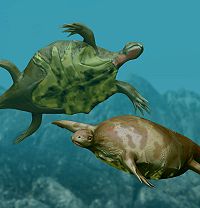 |
||
| 210 Ma | Genus:
|
 |
|||
| 164 Ma |
Genus:
|
An evolutionary bridge between early land turtles and sea turtles. |
|||
From LizardLizardLizards are a widespread group of squamate reptiles, with nearly 3800 species, ranging across all continents except Antarctica as well as most oceanic island chains...
s to SnakeSnakeSnakes are elongate, legless, carnivorous reptiles of the suborder Serpentes that can be distinguished from legless lizards by their lack of eyelids and external ears. Like all squamates, snakes are ectothermic, amniote vertebrates covered in overlapping scales...
s
| The Lizard Lizard Lizards are a widespread group of squamate reptiles, with nearly 3800 species, ranging across all continents except Antarctica as well as most oceanic island chains... → Snake Snake Snakes are elongate, legless, carnivorous reptiles of the suborder Serpentes that can be distinguished from legless lizards by their lack of eyelids and external ears. Like all squamates, snakes are ectothermic, amniote vertebrates covered in overlapping scales... Evolutionary Series |
|||||
|---|---|---|---|---|---|
| Appearance | Taxa | Relationships | Status | Description | Image |
| 92 Ma | Genus:
|
A transitional form between Cretaceous Cretaceous The Cretaceous , derived from the Latin "creta" , usually abbreviated K for its German translation Kreide , is a geologic period and system from circa to million years ago. In the geologic timescale, the Cretaceous follows the Jurassic period and is followed by the Paleogene period of the... lizard Lizard Lizards are a widespread group of squamate reptiles, with nearly 3800 species, ranging across all continents except Antarctica as well as most oceanic island chains... s and limbless snakes retaining distinct, if non-functional, legs. |
|||
| 90 Ma |
Genus:
|
A basal snake with two hind-limbs. | |||
Lizards
| The Lizard Lizard Lizards are a widespread group of squamate reptiles, with nearly 3800 species, ranging across all continents except Antarctica as well as most oceanic island chains... Evolutionary Series |
|||||
|---|---|---|---|---|---|
| Appearance | Taxa | Relationships | Status | Description | Image |
| 61 - 58 Ma | Genus:
|
The earliest known chameleon Chameleon Chameleons are a distinctive and highly specialized clade of lizards. They are distinguished by their parrot-like zygodactylous feet, their separately mobile and stereoscopic eyes, their very long, highly modified, and rapidly extrudable tongues, their swaying gait, the possession by many of a... . |
|||
| 92 Ma |
Genus:
|
A basal mosasauroid from the Upper Cretaceous of North America North America North America is a continent wholly within the Northern Hemisphere and almost wholly within the Western Hemisphere. It is also considered a northern subcontinent of the Americas... . |
|||
| 71 - 82 Ma |
Genus:
|
One of the earliest Varanoidea Varanoidea Varanoidea is a superfamily of lizards, including the well-known family Varanidae . Also included in the Varanoidea are such extinct marine and semi-aquatic forms as mosasaurs and dolichosaurs, the venomous helodermatids , the Lanthanotidae , and the extinct Necrosauridae.Throughout their long... . |
|||
| 146–100 Ma |
Genus:
|
An primitive iguanid | |||
| 97–100 Ma |
Genus:
|
The oldest known gecko Gecko Geckos are lizards belonging to the infraorder Gekkota, found in warm climates throughout the world. They range from 1.6 cm to 60 cm.... |
|||
Pterosaurs
| Rhamphorhynchoidea Rhamphorhynchoidea The Rhamphorhynchoidea forms one of the two suborders of pterosaurs and represent an evolutionary grade of primitive members of this group of flying reptiles. This suborder is paraphyletic in relation to the Pterodactyloidea, which arose from within the Rhamphorhynchoidea, not from a more distant... → Pterodactyloidea Pterodactyloidea Pterodactyloidea forms one of the two suborders of pterosaurs , and contains the most derived members of this group of flying reptiles... Evolutionary Series |
|||||
|---|---|---|---|---|---|
| Appearance | Taxa | Relationships | Status | Description | Image |
| 160 Ma | Genus:
|
Basal to both rhamphorhynchoids and pterodactyloids | |||
| 160 Ma |
Genus
|
||||
Archosaurs to DinosaursEvolution of dinosaursDinosaurs evolved from the archosaurs 232-234 Ma in the Ladinian age, the latter part of the middle Triassic. Dinosauria is a well-supported clade, present in 98% of bootstraps...
| The Archosauria → Dinosauria Series | |||||
|---|---|---|---|---|---|
| Appearance | Taxa | Relationships | Status | Description | Image |
| ??? Ma | Genus:
|
The oldest known archosaur. |
 |
||
| ??? Ma | Genus:
|
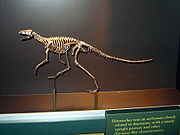 |
|||
| ??? Ma |
Genus:
|
||||
| ??? Ma |
Genus:
|
||||
| 228 Ma |
Genus:
|
 |
|||
Dinosauria
| The Dinosauria Evolutionary Series | |||||
|---|---|---|---|---|---|
| Appearance | Taxa | Relationships | Status | Description | Image |
| 228 to 216.5 Ma | Genus:
|
The oldest known ornithischian. |
|||
| 216–200 Ma | Genus:
|
The most primitive well-known representative of the sauropodomorph dinosaurs. |  |
||
| ??? Ma |
Genus:
|
The oldest and most primitive known stegosaur. | |||
| ??? Ma |
Genus:
|
A basal pachycephalosaur from the Barremian Stage of the Cretaceous Cretaceous The Cretaceous , derived from the Latin "creta" , usually abbreviated K for its German translation Kreide , is a geologic period and system from circa to million years ago. In the geologic timescale, the Cretaceous follows the Jurassic period and is followed by the Paleogene period of the... . |
|||
| 160 Ma |
Genus:
|
A genus of basal ceratopsian dinosaur from the Late Jurassic Late Jurassic The Late Jurassic is the third epoch of the Jurassic Period, and it spans the geologic time from 161.2 ± 4.0 to 145.5 ± 4.0 million years ago , which is preserved in Upper Jurassic strata. In European lithostratigraphy, the name "Malm" indicates rocks of Late Jurassic age... Period of central Asia. |
|||
| 160 Ma |
Genus:
|
A genus of proceratosaurid tyrannosauroid dinosaur, one of the earliest known examples of the lineage. | |||
| 126 Ma |
Genus:
|
A early genus of therizinosaur Therizinosaur Therizinosaurs are theropod dinosaurs belonging to the clade Therizinosauria. Therizinosaur fossils have been found in Early through Late Cretaceous deposits in Mongolia, the People's Republic of China and Western North America... . |
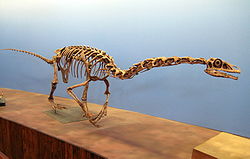 |
||
| 208–194 Ma |
Genus:
|
One of the most primitive thyreophorans. |  |
||
| 130–125 Ma |
Genus:
|
A possible ancestor of the duck-billed dinosaurs. |  |
||
| ??? Ma |
Genus:
|
A primitive (basal) ornithomimosaur. | |||
DinosaurDinosaurDinosaurs are a diverse group of animals of the clade and superorder Dinosauria. They were the dominant terrestrial vertebrates for over 160 million years, from the late Triassic period until the end of the Cretaceous , when the Cretaceous–Paleogene extinction event led to the extinction of...
s to birds
| The Dinosaur Dinosaur Dinosaurs are a diverse group of animals of the clade and superorder Dinosauria. They were the dominant terrestrial vertebrates for over 160 million years, from the late Triassic period until the end of the Cretaceous , when the Cretaceous–Paleogene extinction event led to the extinction of... s → birds Evolutionary Series |
|||||
|---|---|---|---|---|---|
| Appearance | Taxa | Relationships | Status | Description | Image |
| 168-140 Ma | Genus:
|
||||
| 155 Ma |
Genus:
|
Although once classified as a bird, Anchiornis is now considered a basal troodontid Troodontidae Troodontidae is a family of bird-like theropod dinosaurs. During most of the 20th century, troodontid fossils were few and scrappy and they have therefore been allied, at various times, with many dinosaurian lineages... which bears pennaceous, symmetrical feathers on all four limbs. |
Plesiomorphic traits
Derived traits
|
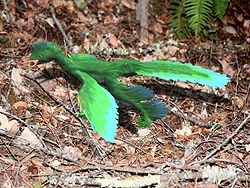 |
|
| 164-158 Ma |
Genus:
|
A small arboreal dinosaur with long arms with wing feathers, Scansoriopteryx could climb well and possibly glide | Maniraptora Maniraptora Maniraptora is a clade of coelurosaurian dinosaurs which includes the birds and the dinosaurs that were more closely related to them than to Ornithomimus velox. It contains the major subgroups Avialae, Deinonychosauria, Oviraptorosauria and Therizinosauria. Ornitholestes and the Alvarezsauroidea... n dinosaur Dinosaur Dinosaurs are a diverse group of animals of the clade and superorder Dinosauria. They were the dominant terrestrial vertebrates for over 160 million years, from the late Triassic period until the end of the Cretaceous , when the Cretaceous–Paleogene extinction event led to the extinction of... , representative of the family Scansoriopterygidae Scansoriopterygidae Scansoriopterygidae is a family of maniraptoran dinosaurs, known from three well-preserved fossils unearthed in the Daohugou fossil beds of Liaoning, China.... |
Plesiomorphic traits
Pubis Pubis may refer to:* Pubis * Mons pubis, a padding of fat that protects the pubis bone... Derived traits
|
|
| 150–145 Ma |
Genus:
|
Known for its mosaic of avian and theropod characteristics Archaeopteryx Archaeopteryx Archaeopteryx , sometimes referred to by its German name Urvogel , is a genus of theropod dinosaur that is closely related to birds. The name derives from the Ancient Greek meaning "ancient", and , meaning "feather" or "wing"... is both the first primitive bird in the fossil record and one of the first transitional fossils discovered. |
Traditionally seen as the first proper bird, though it is not directly ancestral to modern birds. An excellent intermediate form between dinosaurs and birds. Capable of gliding, but lacking alula Alula The alula, or bastard wing, is a small projection on the anterior edge of the wing of modern birds. The alula is the freely moving first digit, a bird's "thumb," and is typically covered with three to five small feathers, with the exact number depending on the species... and keel Keel (bird) A keel or carina in bird anatomy is an extension of the sternum which runs axially along the midline of the sternum and extends outward, perpendicular to the plane of the ribs. The keel provides an anchor to which a bird's wing muscles attach, thereby providing adequate leverage for flight... , it could likely not sustain powered flight. |
Plesiomorphic traits
Keel (bird) A keel or carina in bird anatomy is an extension of the sternum which runs axially along the midline of the sternum and extends outward, perpendicular to the plane of the ribs. The keel provides an anchor to which a bird's wing muscles attach, thereby providing adequate leverage for flight... Alula The alula, or bastard wing, is a small projection on the anterior edge of the wing of modern birds. The alula is the freely moving first digit, a bird's "thumb," and is typically covered with three to five small feathers, with the exact number depending on the species... Derived traits
|
|
| 120 Ma |
Genus:
|
Found in the famous Liaoning province Liaoning ' is a province of the People's Republic of China, located in the northeast of the country. Its one-character abbreviation is "辽" , a name taken from the Liao River that flows through the province. "Níng" means "peace"... Confuciusornis is the first primitive bird with a pygostyle Pygostyle Pygostyle refers to a number of the final few caudal vertebrae fused into a single ossification, supporting the tail feathers and musculature. In modern birds, the rectrices attach to these.... . |
With its short tail and toothless beak, Confuciusornis is very modern looking compared to Archaeopteryx Archaeopteryx Archaeopteryx , sometimes referred to by its German name Urvogel , is a genus of theropod dinosaur that is closely related to birds. The name derives from the Ancient Greek meaning "ancient", and , meaning "feather" or "wing"... . The toothless beak is however a case of convergent evolution Convergent evolution Convergent evolution describes the acquisition of the same biological trait in unrelated lineages.The wing is a classic example of convergent evolution in action. Although their last common ancestor did not have wings, both birds and bats do, and are capable of powered flight. The wings are... , as more advanced birds retained teeth, illustration the sometimes confusing mosaic evolution Mosaic evolution Mosaic evolution is the concept that evolutionary change takes place in some body parts or systems without simultaneous changes in other parts... of the dinosaur-bird transition. |
Plesiomorphic traits
Alula The alula, or bastard wing, is a small projection on the anterior edge of the wing of modern birds. The alula is the freely moving first digit, a bird's "thumb," and is typically covered with three to five small feathers, with the exact number depending on the species... Derived traits
Unlike other early birds Confuciusornis had a toothless beak |
 |
| 115 Ma | Genus:
|
Primitive bird and possibly a descendant of "urvogels" like Archaeopteryx. First bird to possess an alula. | Derived traits
Alula The alula, or bastard wing, is a small projection on the anterior edge of the wing of modern birds. The alula is the freely moving first digit, a bird's "thumb," and is typically covered with three to five small feathers, with the exact number depending on the species... rather than claw |
||
| 93.5-75 Ma |
Genus:
|
Considered a close relative to the ancestor to modern birds | A flying bird found in several epochs in the late Cretaceous which still bore teeth, but in most respects very similar to Neornithes Modern birds Modern birds are the most recent common ancestor of all living birds and all its descendants.Modern birds are characterised by feathers, a beak with no teeth , the laying of hard-shelled eggs, a high metabolic rate, a four-chambered heart, and a lightweight but strong skeleton... . |
Plesiomorphic traits
Derived traits
|
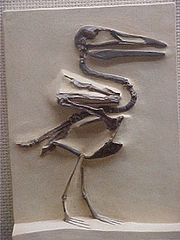 |
Bird Evolution
| The Bird Bird Birds are feathered, winged, bipedal, endothermic , egg-laying, vertebrate animals. Around 10,000 living species and 188 families makes them the most speciose class of tetrapod vertebrates. They inhabit ecosystems across the globe, from the Arctic to the Antarctic. Extant birds range in size from... Evolutionary Series |
|||||
|---|---|---|---|---|---|
| Appearance | Taxa | Relationships | Status | Description | Image |
| 60-58 Ma | Genus:
|
The earliest-known Penguin Penguin Penguins are a group of aquatic, flightless birds living almost exclusively in the southern hemisphere, especially in Antarctica. Highly adapted for life in the water, penguins have countershaded dark and white plumage, and their wings have become flippers... . |
 |
||
| ??? Ma | Genus:
|
An early flamingo Flamingo Flamingos or flamingoes are gregarious wading birds in the genus Phoenicopterus , the only genus in the family Phoenicopteridae... . |
|||
| ??? Ma |
Genus:
|
An early gaviiform Gaviiformes Gaviiformes is an order of aquatic birds containing the loons or divers and their closest extinct relatives. Modern gaviiformes are found in many parts of North America and northern Eurasia , though prehistoric species were more widespread.-Classification and evolution:There are five living... . |
|||
| 55-48 Ma |
Genus:
|
An early psittacine. | |||
| ??? Ma |
Genus:
|
An basal falconiform. | |||
| 50 Ma |
Genus:
|
An early apodiform. | |||
SynapsidSynapsidSynapsids are a group of animals that includes mammals and everything more closely related to mammals than to other living amniotes. They are easily separated from other amniotes by having an opening low in the skull roof behind each eye, leaving a bony arch beneath each, accounting for their name...
("mammal-like reptiles") to mammals
| The Synapsids → Mammals Evolutionary Series | |||||
|---|---|---|---|---|---|
| Appearance | Taxa | Relationships | Status | Description | Image |
| ??? Ma | Genus:
|
||||
| 306 Ma |
Genus:
|
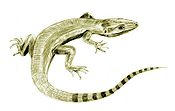 |
|||
| ??? Ma |
Genus:
|
||||
| 265 Ma |
Genus:
|
||||
| ??? Ma |
Genus:
|
 |
|||
| 248-245 Ma |
Genus:
|
 |
|||
| 205 Ma |
Genus:
|
||||
| 125 Ma |
Genus:
|
An early crown group Crown group A crown group is a group consisting of living representatives, their ancestors back to the most recent common ancestor of that group, and all of that ancestor's descendants. The name was given by Willi Hennig, the formulator of phylogenetic systematics, as a way of classifying living organisms... mammal. |
 |
||
Evolution of mammalsEvolution of mammals__FORCETOC__The evolution of mammals within the synapsid lineage was a gradual process that took approximately 70 million years, beginning in the mid-Permian. By the mid-Triassic, there were many species that looked like mammals, and the first true mammals appeared in the early Jurassic...
| The Mammal Mammal Mammals are members of a class of air-breathing vertebrate animals characterised by the possession of endothermy, hair, three middle ear bones, and mammary glands functional in mothers with young... Evolutionary Series |
|||||
|---|---|---|---|---|---|
| Appearance | Taxa | Relationships | Status | Description | Image |
| 100–104 Ma | Genus:
|
The earliest-known monotreme Monotreme Monotremes are mammals that lay eggs instead of giving birth to live young like marsupials and placental mammals... to date. |
|||
| 125 Ma | Genus:
|
The oldest metatherian known. |
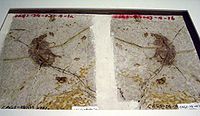 |
||
| ?? Ma | Genus:
|
The earliest-known marsupial Marsupial Marsupials are an infraclass of mammals, characterized by giving birth to relatively undeveloped young. Close to 70% of the 334 extant species occur in Australia, New Guinea, and nearby islands, with the remaining 100 found in the Americas, primarily in South America, but with thirteen in Central... . |
 |
||
| 125 Ma | Genus:
|
The oldest known eutherian. |
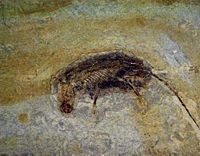 |
||
| 63-50 Ma | Genus:
|
The earliest known proboscidean. |
|||
| 60-55 Ma | Genus:
|
The ancestor of the modern Order Carnivora Carnivora The diverse order Carnivora |Latin]] carō "flesh", + vorāre "to devour") includes over 260 species of placental mammals. Its members are formally referred to as carnivorans, while the word "carnivore" can refer to any meat-eating animal... . |
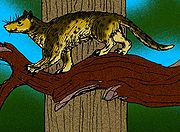 |
||
| 15.97–11.61 Ma | Genus:
|
The earliest known cervid. |
|||
| 20-18 Ma | Genus:
|
The earliest known bovid Bovid A bovid is any of almost 140 species of cloven-hoofed ruminant mammal at least the males of which bear characteristic unbranching horns covered in a permanent sheath of keratin.... . |
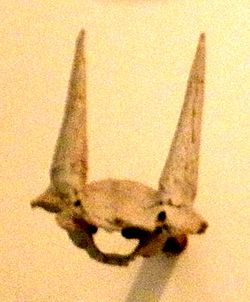 |
||
| 45-40 Ma | Genus:
|
The oldest camel Camel A camel is an even-toed ungulate within the genus Camelus, bearing distinctive fatty deposits known as humps on its back. There are two species of camels: the dromedary or Arabian camel has a single hump, and the bactrian has two humps. Dromedaries are native to the dry desert areas of West Asia,... known, it was also the smallest. |
|||
| ??? Ma | Genus:
|
Suspected to be the ancestor of modern tapirs and rhinoceroses. |
|||
| 55.4—48.6 Ma | Genus:
|
Suspected to be the ancestor of modern tapirs. |
 |
||
| 38—33.9 Ma | Genus:
|
The earliest of the canids. |
 |
||
| ??? Ma | Genus:
|
The earliest of the lagomorphs. |
|||
| 52.5 Ma | Genus:
|
One of the most primitive of the two oldest known monospecific genera of bat Bat Bats are mammals of the order Chiroptera "hand" and pteron "wing") whose forelimbs form webbed wings, making them the only mammals naturally capable of true and sustained flight. By contrast, other mammals said to fly, such as flying squirrels, gliding possums, and colugos, glide rather than fly,... . |
|||
| 2 Ma | Genus:
|
The earliest known ancestor of the Giant Panda Giant Panda The giant panda, or panda is a bear native to central-western and south western China. It is easily recognized by its large, distinctive black patches around the eyes, over the ears, and across its round body. Though it belongs to the order Carnivora, the panda's diet is 99% bamboo... . |
|||
| 63 - 61.7Ma | Genus:
|
Believed to be the earliest example of a primate Primate A primate is a mammal of the order Primates , which contains prosimians and simians. Primates arose from ancestors that lived in the trees of tropical forests; many primate characteristics represent adaptations to life in this challenging three-dimensional environment... or a proto-primate, a primatomorph precursor to the Plesiadapiformes Plesiadapiformes Plesiadapiformes is an extinct order of mammals. It is either closely related to the primates or a precursor to them. Many are too derived to be ancestral to primates, but the earliest Plesiadapiformes have teeth that are strongly indicative of a common ancestor... . |
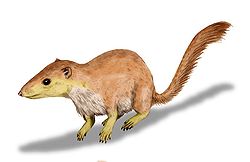 |
||
| 12.5-8.5 Ma |
Genus:
|
This genus may have been the ancestor to the modern orangutan Orangutan Orangutans are the only exclusively Asian genus of extant great ape. The largest living arboreal animals, they have proportionally longer arms than the other, more terrestrial, great apes. They are among the most intelligent primates and use a variety of sophisticated tools, also making sleeping... s. |
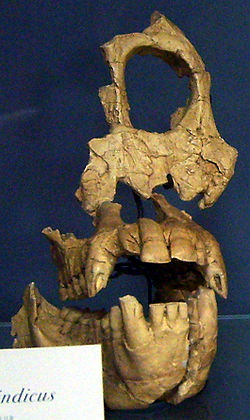 |
||
| 16 - 8 Ma | Genus:
|
An possible ancestor of living hippopotamids. | |||
| ?? Ma |
Genus:
|
The earliest known true (and scaled) pangolin Pangolin A pangolin , also scaly anteater or Trenggiling, is a mammal of the order Pholidota. There is only one extant family and one genus of pangolins, comprising eight species. There are also a number of extinct taxa. Pangolins have large keratin scales covering their skin and are the only mammals with... . |
|||
Early Artiodactylans to whaleWhaleWhale is the common name for various marine mammals of the order Cetacea. The term whale sometimes refers to all cetaceans, but more often it excludes dolphins and porpoises, which belong to suborder Odontoceti . This suborder also includes the sperm whale, killer whale, pilot whale, and beluga...
s (Evolution of whales)
| The whale Whale Whale is the common name for various marine mammals of the order Cetacea. The term whale sometimes refers to all cetaceans, but more often it excludes dolphins and porpoises, which belong to suborder Odontoceti . This suborder also includes the sperm whale, killer whale, pilot whale, and beluga... Evolutionary Series |
|||||
|---|---|---|---|---|---|
| Appearance | Taxa | Relationships | Status | Description | Image |
| 55.8 ± 0.2 - 33.9 ± 0.1 Ma | Genus:
|
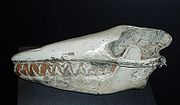 |
|||
| 50 Ma |
Genus:
|
 |
|||
| 46 Ma |
Genus:
|
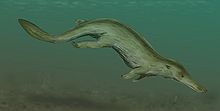 |
|||
| 47 Ma |
Genus:
|
||||
| 41-33 Ma |
Genus:
|
 |
|||
| 25 Ma |
Genus:
|
 |
|||
| 40-34 Ma |
Genus:
|
||||
| 8-15 Ma |
Genus:
|
 |
|||
| 26 Ma |
Genus:
|
||||
Evolution of sireniansEvolution of sireniansSirenia is the order of placental mammals which comprise modern "sea cows" and their extinct relatives. They are the only extant herbivorous marine mammals and the only group of herbivorous mammals to have become completely aquatic. Sirenians are thought to have a 50-million-year-old fossil record...
| The Sirenia Sirenia Sirenia is an order of fully aquatic, herbivorous mammals that inhabit swamps, rivers, estuaries, marine wetlands, and coastal marine waters. Four species are living, in two families and genera. These are the dugong and manatees... Evolutionary Series |
|||||
|---|---|---|---|---|---|
| Appearance | Taxa | Relationships | Status | Description | Image |
| 50 Ma | Genus:
|
A primitive sirenian. |
|||
| 40 Ma | Genus:
|
 |
|||
| ??? Ma | Genus:
|
||||
| 48.6–33.9 Ma |
Genus:
|
An evolutionary bridge between primitive land-dwelling sirenians to aquatic sirenians |
|||
| ??? Ma | Genus:
|
 |
|||
Evolution of the Pinnipeds
| The Pinniped Pinniped Pinnipeds or fin-footed mammals are a widely distributed and diverse group of semiaquatic marine mammals comprising the families Odobenidae , Otariidae , and Phocidae .-Overview: Pinnipeds are typically sleek-bodied and barrel-shaped... Evolutionary Series |
|||||
|---|---|---|---|---|---|
| Appearance | Taxa | Relationships | Status | Description | Image |
| 21 to 24 Ma | Genus:
|
The oldest known pinniped. |
|||
| ??? Ma | Genus:
|
A very basal pinniped. |  |
||
| 24-22 Ma |
Genus:
|
An early seal, but with more primitive skull and feet. |
 |
||
Evolution of the horseEvolution of the horseThe evolution of the horse pertains to the phylogenetic ancestry of the modern horse from the small dog-sized, forest-dwelling Hyracotherium over geologic time scales...
| The Hyracotherium Hyracotherium Hyracotherium , also known as Eohippus or the dawn horse, is an extinct genus of very small perissodactyl ungulates that lived in the woodlands of the northern hemisphere, with species ranging throughout Asia, Europe, and North America during the early Tertiary Period and the early to mid Eocene... → Equus Equus (genus) Equus is a genus of animals in the family Equidae that includes horses, donkeys, and zebras. Within Equidae, Equus is the only extant genus. Like Equidae more broadly, Equus has numerous extinct species known only from fossils. This article deals primarily with the extant species.The term equine... Evolutionary Series |
|||||
|---|---|---|---|---|---|
| Appearance | Taxa | Relationships | Status | Description | Image |
| 60-45 Ma | Genus:
|
 |
|||
| 40-30 Ma |
Genus:
|
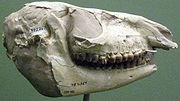 |
|||
| 20 Ma |
Genus:
|
 |
|||
| 17-11 Ma |
Genus:
|
||||
| 12 Ma |
Genus:
|
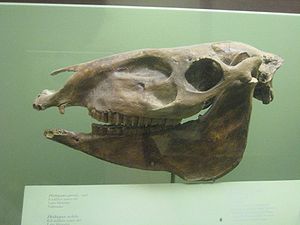 |
|||
| 1.8-0 Ma |
Genus:
|
 |
|||
Human evolutionHuman evolutionHuman evolution refers to the evolutionary history of the genus Homo, including the emergence of Homo sapiens as a distinct species and as a unique category of hominids and mammals...
| The Human Human Humans are the only living species in the Homo genus... Evolutionary Series |
|||||
|---|---|---|---|---|---|
| Appearance | Taxa | Relationships | Status | Description | Image |
| 36-32 Ma | Genus
|
The oldest primitive monkey known in the fossil record, dating back before the split between Old and New world monkeys. | Basal to both Old and New world monkeys. | Plesiomorphic traits
Parapithecus Parapithecus is an extinct genus of primates. There are two known species.-Species:*†Parapithecus fraasi Schlosser 1910*†Parapithecus grangeri Simons 1974... Derived traits
|
|
| 33 Ma |
Genus
|
A Miocene monkey which bridges the gap between the Eocene ancestors of Old world monkeys and Miocene ancestor of Hominoidae. | Tentatively positioned transitional form prior to the Old world monkey/ape split. | Plesiomorphic traits
Brachiation Brachiation is a form of arboreal locomotion in which primates swing from tree limb to tree limb using only their arms.- Brachiators :... unlike extant apes Apidium The genus Apidium is that of at least three extinct primates living in the early Oligocene, roughly 36 to 32 millions years ago. Apidium fossils are common in the Fayoum deposits of Egypt... Derived traits
|
|
| 27-14 Ma |
Genus
|
This primate has very ape-like features like its teeth, but much of its post-cranial remains are more similar to monkeys. | Universally accepted to be intermediate between 'ape-like monkeys' such as Aegyptopithecus and later apes including hominids. | Plesiomorphic traits
Derived traits
|
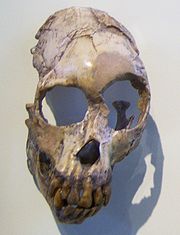 |
| 13 Ma |
Genus:
|
A European ape which is considered to be the predecessor of the great apes. | Some objections have been raised to this fossils status due to its location in Spain, but Pierolapithecus is likely a transitional taxon between generalized apes and the lineage which led to great apes. | Pleisomorphic traits
Derived traits
|
|
| 4.4 Ma |
Genus:
|
A woodland hominid adapted to quadruped arboreal locamotion, but also for bipedalism. | Intermediate between the last common ancestor of chimps and humans, and the australopithecines Australopithecus Australopithecus is a genus of hominids that is now extinct. From the evidence gathered by palaeontologists and archaeologists, it appears that the Australopithecus genus evolved in eastern Africa around 4 million years ago before spreading throughout the continent and eventually becoming extinct... . |
Plesiomorphic traits
Hallux In tetrapods, the hallux is the innermost toe of the foot. Despite its name it may not be the longest toe on the foot of some individuals... Australopithecus Australopithecus is a genus of hominids that is now extinct. From the evidence gathered by palaeontologists and archaeologists, it appears that the Australopithecus genus evolved in eastern Africa around 4 million years ago before spreading throughout the continent and eventually becoming extinct... Derived traits
|
|
| 4.4-2.0 Ma |
Genus:
|
First known genus of fully bipedal apes which are probably ancestral to robust australopiths Paranthropus The robust australopithecines, members of the extinct hominin genus Paranthropus , were bipedal hominids that probably descended from the gracile australopithecine hominids... and the genus Homo Homo Homo may refer to:*the Greek prefix ὅμο-, meaning "the same"*the Latin for man, human being*Homo, the taxonomical genus including modern humans... |
Intermediate between extinct quadrupedal and bipedal apes. While the relationship between some species are being revised, Australopithecus afarensis Australopithecus afarensis Australopithecus afarensis is an extinct hominid that lived between 3.9 and 2.9 million years ago. A. afarensis was slenderly built, like the younger Australopithecus africanus. It is thought that A... is considered to be, by most experts, the ancestor to all later hominids. |
Plesiomorphic traits
Sagittal crest A sagittal crest is a ridge of bone running lengthwise along the midline of the top of the skull of many mammalian and reptilian skulls, among others.... Derived traits
|
 |
| 2.5-1.5 Ma |
Species:
|
An early human which is the morphological link between australopithecine Australopithecine The term australopithecine refers generally to any species in the related genera Australopithecus or Paranthropus. These species occurred in the Plio-Pleistocene era, and were bipedal and dentally similar to humans, but with a brain size not much larger than modern apes, lacking the... s and later human species. |
Perfect intermediate between early hominids and later humans, possibly ancestral to modern humans. | Plesiomorphic traits
Derived traits
|
 |
| 2.0-1.0 Ma |
Species:
|
Very successful hominid, which was probably ancestral to both modern humans and neanderthals. Probably the first hominid to leave and successfully colonize territories outside of Africa. | Ancestral to modern humans and neanderthals. | Plesiomorphic traits
Derived traits
|
 |
| 500 Ka-recent |
Species
|
Archaic sapiens were the immediate ancestors of modern humans which evidently displaced the neanderthal Neanderthal The Neanderthal is an extinct member of the Homo genus known from Pleistocene specimens found in Europe and parts of western and central Asia... s in Europe and the island 'hobbits' Homo floresiensis Homo floresiensis is a possible species, now extinct, in the genus Homo. The remains were discovered in 2003 on the island of Flores in Indonesia. Partial skeletons of nine individuals have been recovered, including one complete cranium... of southeast Asia. 'Archaic' sapiens evolved from H. erectus about half a million years ago but still retains some primitive characteristics such as relatively thick bones and molars larger than modern humans. |
Ancestral to modern humans. | ||
See also
- Chimpanzee genome project — Genes of the Chromosome 2 fusion site
- List of fossil sites (with link directory)
- List of human evolution fossils
- Transitional fossilTransitional fossilA transitional fossil is any fossilized remains of a lifeform that exhibits characteristics of two distinct taxonomic groups. A transitional fossil is the fossil of an organism near the branching point where major individual lineages diverge...
External links
- Vuletic.com, Section V: Paleontology – Transitional fossils between every animal group
- Palaeos.com, Palaeos vertebrates starting with lobe-finned fish (very comprehensive)
- Talk.origins.org, FAQ: Transitional vertebrate fossils
- (A few) transitional fossils

